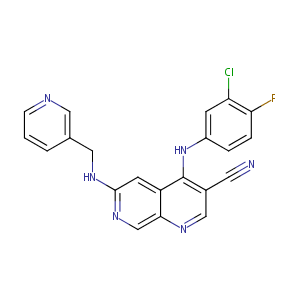Details of the Drug
General Information of Drug (ID: DMHATCZ)
| Drug Name |
Tpl2 kinase inhibitor
|
||||||||||||||||||||||
|---|---|---|---|---|---|---|---|---|---|---|---|---|---|---|---|---|---|---|---|---|---|---|---|
| Synonyms |
Tpl2 Kinase Inhibitor; 871307-18-5; 4-((3-Chloro-4-fluorophenyl)amino)-6-((pyridin-3-ylmethyl)amino)-1,7-naphthyridine-3-carbonitrile; CHEMBL200381; 4-[(3-CHLORO-4-FLUOROPHENYL)AMINO]-6-[(3-PYRIDINYLMETHYL)AMINO]-1,7-NAPHTHYRIDINE-3-CARBONITRILE; 4-(3-Chloro-4-fluorophenylamino)-6-(pyridin-3-yl-methylamino)-3-cyano-[1,7]-naphthyridine; K00599a; 4-[(3-chloro-4-fluorophenyl)amino]-6-[(pyridin-3-ylmethyl)amino]-1,7-naphthyridine-3-carbonitrile
|
||||||||||||||||||||||
| Indication |
|
||||||||||||||||||||||
| Drug Type |
Small molecular drug
|
||||||||||||||||||||||
| Structure |
 |
||||||||||||||||||||||
| 3D MOL is unavailable | 2D MOL | ||||||||||||||||||||||
| #Ro5 Violations (Lipinski): 0 | Molecular Weight (mw) | 404.8 | |||||||||||||||||||||
| Logarithm of the Partition Coefficient (xlogp) | 4.4 | ||||||||||||||||||||||
| Rotatable Bond Count (rotbonds) | 5 | ||||||||||||||||||||||
| Hydrogen Bond Donor Count (hbonddonor) | 2 | ||||||||||||||||||||||
| Hydrogen Bond Acceptor Count (hbondacc) | 7 | ||||||||||||||||||||||
| Chemical Identifiers |
|
||||||||||||||||||||||
| Cross-matching ID | |||||||||||||||||||||||
Molecular Interaction Atlas of This Drug
 Drug Therapeutic Target (DTT) |
|
||||||||||||||||||||||||||
|---|---|---|---|---|---|---|---|---|---|---|---|---|---|---|---|---|---|---|---|---|---|---|---|---|---|---|---|
| Molecular Interaction Atlas (MIA) | |||||||||||||||||||||||||||
References
